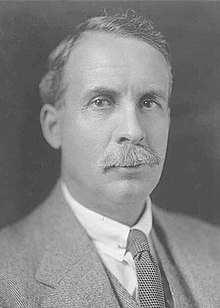George Pearce
Sir George Pearce | |
|---|---|
 | |
| Leader of the Government in the Senate | |
| In office 6 January 1932 – 29 November 1937 | |
| Preceded by | John Barnes |
| Succeeded by | Alexander McLachlan |
| Senator for Western Australia | |
| In office 29 March 1901 – 30 June 1938 | |
| Personal details | |
| Born | 14 January 1870 Mount Barker, South Australia |
| Died | 24 June 1952 (aged 82) Elwood, Victoria |
| Political party | Labor (1901–17) Nationalist (1917–31) UAP (1931–38) |
| Spouse | Eliza Maud Barrett |
| Occupation | Carpenter |
Sir George Foster Pearce KCVO (14 January 1870 – 24 June 1952) was an Australian politician who was instrumental in founding the Australian Labor Party in Western Australia.
Pearce, a carpenter, was born in Mount Barker, South Australia, to James Pearce (c. 1833 – 17 April 1919),[1] a Cornish Australian,[2] whose brother Charles Pearce (1826–1908) was MHA for East Torrens 1868–1870. He was educated at Red Hill Public School until he was 11, then worked on farms and later became a carpenter in Adelaide, but lost that job in the depression of 1891 and moved to Western Australia. He joined the Amalgamated Society of Carpenters and Joiners and soon became heavily involved in the union movement. In April 1897 he married Eliza Maud Barrett.[3]
Political career
In 1893, Pearce helped found the Progressive Political League, a precursor to the West Australian branch of the ALP. Self-educated in politics and economics, in 1901 he was elected to the first Commonwealth Parliament as a Senator for Western Australia. He narrowly missed out on being a member of the first Labor Party Cabinet when Chris Watson became Prime Minister in 1904. In 1908, he became Minister for Defence in the Cabinet of Andrew Fisher. He oversaw the foundation of the naval college at Jervis Bay and Royal Military College, Duntroon. In 1914 Australia entered World War I. Upon Billy Hughes' ascension as Prime Minister, Pearce was named Deputy Leader of the party.[3]
By this time, Australia's prosecution of the war made the introduction of conscription an intensely divisive issue for the ALP. Pearce was convinced of the necessity of introducing conscription, but the majority of his party did not agree. Pearce, along with many other of the party's founding members, subsequently followed Hughes out of the party and into the new "National Labor Party." A few months later, the National Labor Party merged with the Commonwealth Liberal Party to form the Nationalist Party, with Hughes as its leader.[3]
For much of 1916, Prime Minister Hughes was out of the country as a member of the Imperial war cabinet. During this time, over seven months, Pearce was acting prime minister, and the last person to rule for any length of time from the Senate.
Most of the defectors to the Nationalists subsequently faded into obscurity, but Pearce went on to have a successful career in the party of his erstwhile opponents. After Hughes was deposed as Nationalist leader, Pearce accepted a position in the ministry of Hughes' successor and rival, Stanley Bruce. He became the inaugural Father of the Senate in 1923. He was appointed a Knight Commander of the Royal Victorian Order (KCVO) in 1927.[4] In 1932, Pearce joined the newly formed United Australia Party, and served as a minister in the government of Joseph Lyons until his defeat at the 1937 election (his term ended in June 1938). He was a Senator for 37 years and three months, a record term. His total service as a minister was 24 years and seven months, also a record in the Australian Parliament. At the time of his death, he was the last surviving member of the 1901-1907 Senate, which includes the first Australian Parliament - though MHR's Billy Hughes and King O'Malley would outlive him.[3]
Pearce died at home in the Melbourne suburb of Elwood, survived by two sons and two daughters.[3] RAAF Base Pearce, the Electoral Division of Pearce and the Canberra suburb of Pearce are named after him.
Notes
- ^ "Obituary". The Mount Barker Courier and Onkaparinga and Gumeracha Advertiser (SA : 1880 - 1954). SA: National Library of Australia. 18 April 1919. p. 2. Retrieved 15 July 2015.
- ^ Payton, Philip. The Cornish Overseas, 2005.
- ^ a b c d e Beddie, B. (1988). "Pearce, Sir George Foster (1870 - 1952)". Australian Dictionary of Biography. Canberra: National Centre of Biography, Australian National University. ISBN 978-0-522-84459-7. ISSN 1833-7538. OCLC 70677943. Retrieved 20 October 2007.
- ^ It's an Honour: KCVO
External links
- 1870 births
- 1952 deaths
- Australian Labor Party members of the Parliament of Australia
- Australian ministers for Foreign Affairs
- Australian people of Cornish descent
- Nationalist Party of Australia members of the Parliament of Australia
- United Australia Party members of the Parliament of Australia
- Members of the Australian Senate for Western Australia
- Members of the Australian Senate
- Members of the Cabinet of Australia
- Australian federationists
- Australian Knights Commander of the Royal Victorian Order
- Members of the Privy Council of the United Kingdom
- Officiers of the Légion d'honneur
- Australian carpenters
- National Labor Party members of the Parliament of Australia
- Defence ministers of Australia
- 20th-century Australian politicians
